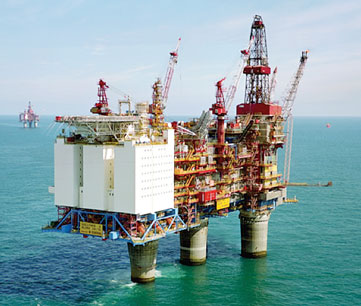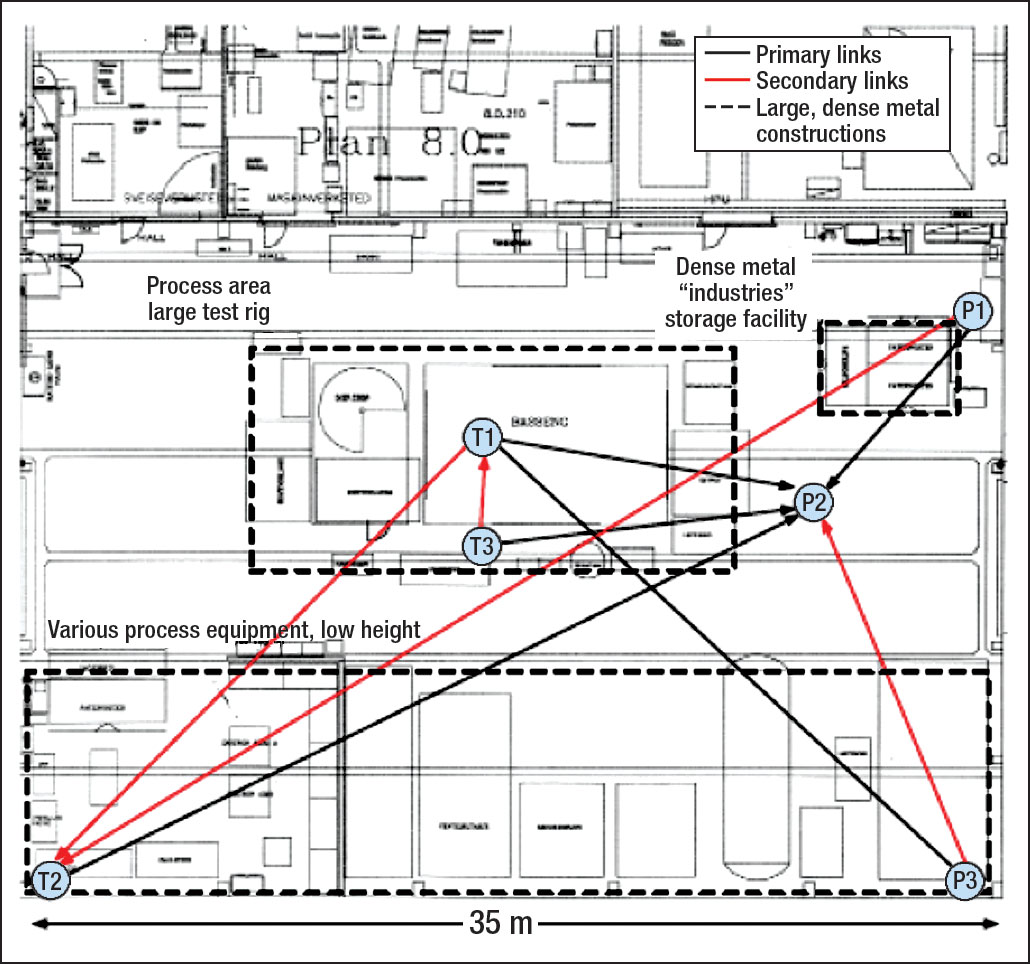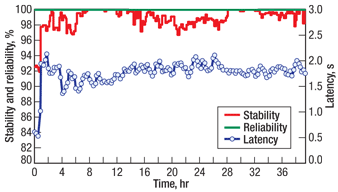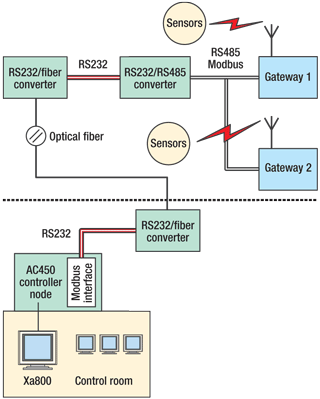Using wireless temperature sensors to detect loss of flow presented a low-cost solution for increasing production at an offshore facility.Simon Carlsen and Amund Skavhaug, StatoilHydro ASA, Norway; Stig Petersen, Sintef ICT; and Paula Doyle, ABB A wireless sensor network was deployed at the Gullfaks offshore oil and gas facility in the North Sea. At Gullfaks Field, decline in flowline pressure occasionally causes loss of flow from wells. This is not readily detected, and leads to large financial losses. The installation and maintenance of a traditional detection system is costly and complex, and requires a production shutdown. In this case, a wireless temperature sensor network was chosen to predict the loss of flow from a well. Before deployment, the solution was tested in a semi-industrial environment to ensure that it fulfilled all requirements. The network enabled quick, relatively inexpensive and reliable detection of lost flow, thus enabling prompt action to reestablish flow. INTRODUCTION The IEEE 802.15.4 specification for the physical layer (PHY) and Medium Access Control layer (MAC) for low-rate personal area networks1 has enabled the development of low-cost, low-power wireless sensor nodes. Based on this standard, a growing number of Wireless Sensor Networks (WSNs), both standardized and proprietary, are emerging. For the oil and gas industry, using WSNs for wireless instrumentation has many benefits. It enables installation in remote and hostile areas that are too costly or complex for wired instrumentation, and the ad hoc nature of WSNs allows temporary and mobile installations. In addition, with the introduction of cheap and easy-to-install wireless sensors, more sensors can be deployed, which leads to redundant data collection for production optimization. Calculations performed by StatoilHydro show that wireless instrumentation can reduce construction costs, as much as 5% for new facilities. With typical construction costs of $10 billion, this represents significant savings. For modification of existing facilities, the potential savings can be even larger. The WSN application described in this article builds upon previous work in which two wireless sensor network technologies were deployed in a semi-industrial laboratory.2 That work concluded that an open and energy-efficient standard is needed before WSN technologies can be fully adopted by the oil and gas industry. However, the present article demonstrates how wireless temperature sensors solved an urgent problem regarding loss of oil production at the Gullfaks offshore facility. GULLFAKS APPLICATION The Gullfaks oil field in the Norwegian North Sea was discovered in 1978, and production started in December 1986. The field has sea depth of 430–720 ft and consists of three integrated processing, drilling and accommodation facilities: Gullfaks A, B and C, Fig. 1. Production at Gullfaks is in the tail-end phase; the recovery factor is 58%, but the goal is to increase it to 62%.
The Gullfaks reservoirs consist of Middle Jurassic sandstones in the Brent group, and Lower Jurassic and Upper Triassic sandstones in the Cook, Statfjord and Lunde Formations. The reservoirs, at 5,600–6,600 ft below sea level, consist of many small oil accumulations. Because there are many limited “pockets” containing oil, production perforations have lifetimes ranging from 6 months to 10 years. As a well production perforation is in the tail-end stage of its lifecycle, a decline in wellhead pressure occasionally causes loss of flow. When the pressure is only slightly above the inlet separator pressure, the flowrate from the well is reduced to a point where separation of liquid and gas in the well fluid column can result in a total loss of flow. This loss is not readily detected, as the well flowlines do not contain flowmeters. A simple approach to determine loss of flow in a well is to measure the temperature of the flowline some distance downstream of the wellhead. This is based on the principle that loss of flow lowers the pipe temperature because heat is lost to the surroundings without well fluids to maintain the temperature. The typical well fluid temperature is about 60°C; thus, the temperature measurement can be performed on the pipe’s surface. This eliminates the need for an invasive and complex installation. Prior to WSN installation, flow loss from individual wells was detected by plant operators manually probing the surface temperature of the flowlines when making inspection rounds in the area one or two times each 12-hr shift. Temperature measurement is already in common use as an indication of flow from individual subsea wellheads, where temperature sensors are routinely installed. However, in the subsea environment the ambient conditions are known and relatively constant, whereas in the Gullfaks case the ambient temperature varies with season and weather. To compensate for varying ambient temperature, the sensor units’ secondary, internal temperature sensors (for cold-junction compensation or monitoring of transmitter internals) may be used. Traditional sensor equipment requires cables for both wired power and a wired communication link, resulting in high complexity and cost of installation including a production shutdown. However, these barriers are reduced with the introduction of battery-operated wireless temperature sensors clamped onto the outer surface of the pipes. GULLFAKS REQUIREMENTS With the exception of safety and power consumption, which are general requirements for the oil and gas industry, the requirements presented here are specific for the Gullfaks application. Safety requirements of the European Union for equipment intended for use in hazardous locations vary based on the equipment’s level of explosion resistance, and are found in the 94/9/EC ATEX directive.3 (The acronym is an abbreviation of the French term atmosphère explosible.) Reliability. In its context here, reliability is a measure of the percentage of sensor data that reaches its destination, usually the gateway, which then transmits the data to the Process Control and Data Acquisition (PCDA) system. The term is often used in conjunction with stability, which is the percentage of successfully transmitted data packets in the network on an individual link basis (the inverse of packet loss). In IEEE 802.15.4-based networks, transfer of data is based on acknowledgement (shorthand: ACK). The transmitter expects to receive an ACK from the receiver for each transmitted packet. If the ACK is not received within a certain time, the packet is re-transmitted. Thus, in an ACK-based network, it is possible to achieve 100% reliability (no sensor data loss) while experiencing only 90% stability, due to re-transmission of packets. For the oil and gas industry, reliability is application dependent. In general, the requirement for a Health, Safety or Environmental (HSE) application is 99.9%. Latency. Latency is a measure of time delay, or lag. It is defined as the time between transmission of a data packet from the originating sensor and its arrival at the receiver. One factor affecting latency is link quality, which commonly relates to the signal-to-noise ratio in the Radio Frequency (RF) domain. Poor link quality increases the number of re-transmissions, thus increasing latency. Another factor is hop count. In an IEEE 802.15.4-based full-mesh sensor network, every sensor works both as a sensor unit and as a routing device capable of forwarding packets from neighboring sensors toward the gateway. When packets have to “hop” from one sensor to another to reach the gateway, latency increases. The Gullfaks temperature measurement application is considered non-critical with respect to the allowed absolute maximum latency. However, a general recommendation is to allow a 2-s maximum latency. Temperature measurements. The temperature range on the flowline surfaces of interest at Gullfaks A is about 50–70°C during normal operation. A lower threshold limit is usually set in the PCDA. When temperature drops to this value, an alarm is triggered to indicate a pressure loss. The threshold value varies slightly from well to well, depending on the well characteristics. Table 1 shows examples of operating temperatures and lower threshold values (alarm limits) for four wells at Gullfaks A.
The typical threshold limit is in the range of 2–10°C below the normal operating temperature. Based on this, a measurement interval between 35°C and 85°C is considered adequate for the Gullfaks application. With regard to temperature measurement, accuracy can be defined in several ways. Two typical quantifications of accuracy are a) the numeric resolution of the measurement readout; and b) a measure of how well correlated the metric is with the physical quantity; e.g., is there an offset between the two? If so, is this offset linear as the physical quantity varies? For the Gullfaks application, a reliable relationship between measurement data and the actual temperature is much more important than high-resolution (multi-decimal) readings. A resolution of 1°C is considered sufficient for this application. In addition, if there is a deviation between real temperature and measured temperature, it is important that this offset is constant. Since we are dealing with a clamp-on system, a lag is introduced, from the instant the oil temperature inside the pipe starts to change until this change is detected by the surface-mounted sensor. However, this lag is not considered significant for the application. Integration with PCDA system. To achieve the goal of the Gullfaks application, namely to measure, in a timely fashion, losses of flow in the wells, real-time temperature monitoring is required. Integration with the plant’s existing PCDA is a consequence of this requirement. The Gullfaks plant is running the ABB 800xA Distributed Control System (DCS). The wireless gateway provides an RS485 Modbus interface. An ABB AC450 controller node with a CI532V02 module serves as the Modbus interface on the PCDA side. The input of the Modbus interface is an RS232 serial interface, supporting data rates of 9,600 kb/s, 19,200 kb/s, 38,400 kb/s and 57,600 kb/s. Proper conversion from RS485 Modbus to RS232 is therefore a requirement. Furthermore, the PCDA must be able to integrate the measured sensor data with the existing graphical views. It should also be possible for the operator to set alarm limits easily, and to monitor the sensor nodes’ remaining battery capacities from the DCS, to avoid unexpected loss of sensor data and enable better planning of maintenance. Power consumption. Various factors affect the power consumption of a wireless sensor node, including: • Update rate: A high update rate increases power consumption as the number of transmissions per time unit increases. • Routing activity: A sensor node close to the gateway is likely to use more power forwarding packets from remote sensors, compared to sensors located in the outer areas. • Link quality: Because packet transmission is ACK-based, poor link quality will cause more re-transmissions, thus increasing power consumption. Since the wireless sensor nodes are battery operated, low power consumption is required to lengthen the intervals between battery replacements. The oil and gas industry’s general requirement for wireless sensors is a 5-yr battery lifetime. Update rates. Because the update rate of the sensor data affects power consumption, there is a tradeoff between the update rate and sensor battery life. For the Gullfaks application, an update rate of 30 s for the temperature data to the PCDA is deemed sufficient. Transmission range. The initial requirement is that all flowlines on the process deck should be within radio range of one wireless gateway. Studying the proposed individual sensor placements, a radio range of about 25 m is required. TECHNOLOGY The oil and gas industry has worked out a set of technical requirements for the deployment of wireless technology.4 These include a preference for standardized, open communication protocols vs. proprietary protocols, so operators can choose between several suppliers while being ensured interoperability. Several international standards for industrial WSNs are emerging, all of them based on IEEE 802.15.4 PHY. ZigBee PRO. The ZigBee specification5 has been regarded by the industry as not robust enough for applications in harsh RF environments, mainly because of its lack of frequency hopping. To address this issue, the ZigBee Alliance released the ZigBee PRO specification in October 2007.6 ZigBee PRO is aimed at the industrial market, and it is capable of “frequency agility”—a concept in which the entire network changes the operative channel when exposed to noise and/or interference. WirelessHART. The WirelessHART protocol was ratified in September 2007 as part of the HART Field Communication Specification, Revision 7.0, allowing for wireless transmission of HART messages.7 WirelessHART implements frequency hopping and a multi-hop full-mesh network topology. Time-Division Multiple Access (TDMA) is the channel access method, dividing the communication into distinct time slots. Each time slot is reserved for a specific communication link in the network, ensuring contest-free utilization of the radio channel. ISA100.11a. The ISA100 standards committee aims to deliver a family of standards for industrial automation. The first standard to emerge, ISA100.11a Release 1, provides secure and reliable wireless connectivity for fixed, portable and moving devices for non-critical monitoring and control applications.8 ISA100.11a defines a frequency-hopping, multi-hop star-mesh network capable of inter-network routing. In May 2008, the ISA100 standards committee created a new subcommittee to investigate options for the convergence of the ISA100.11a and WirelessHART standards. The resultant single standard will then be published as a subsequent release of ISA100.11a. Proprietary solutions. None of these WSN solutions was ratified for the Gullfaks scenario. Previous work has shown that the WSN solution from Dust Networks is capable of robust and reliable operation in harsh RF environments similar to what is found at Gullfaks.2 Furthermore, the DUST wireless communications protocol is extremely similar to the WirelessHART protocol. An ATEX version of this technology was chosen. LAB TESTS Deployment and installation of equipment at an offshore platform is a costly and time-consuming procedure. To ensure that the chosen system complied with the Gullfaks requirements, the system was tested in the laboratory facilities at StatoilHydro’s Research Centre in Trondheim, Norway, using real-size replicas of equipment used in StatoilHydro’s installations. The test network comprised five wireless transmitters and one gateway. It was deployed and monitored for about 40 hr. The wireless transmitters were positioned to provide a challenge to the capabilities of the network, especially regarding wireless communication in areas with lots of metal structures and no direct line-of-sight conditions, Fig. 2.
The network performance (latency, stability and reliability) is shown in Fig. 3. The network has an initialization phase of about 1–2 hr, during which the mesh network topology is created and the optimal routes are chosen based on a tradeoff between high stability/reliability and low latency. After this initial phase, the network remained stable for the duration of the test period. The latency varied from about 1.5 s to 2 s, the stability ranged 96–100%, and the reliability remained at 100% for the entire test period.
It is worth noting that, during the first hour of operation, latency was significantly lower than for the rest of the period. The reason for this is that, during the first hour, the SmartMesh protocol utilized a shorter frame length (1 s) in order to facilitate fast joining of sensor nodes. For the rest of the test period, the frame rate was just below 5 s. Based on these positive results in conjunction with results from experiments performed on a non-ATEX-certified version of the same technology,2 the wireless system was deemed ready for deployment. DEPLOYMENT Installation on Gullfaks A was conducted by the facility’s local telecommunications and IT staff. Configuration on the PCDA system was done in close cooperation with well engineers. Physical installation. Thirteen Emerson Rosemount type-648 wireless temperature transmitters were installed on flowlines at the process deck. The Emerson 1420 gateway was installed on one side of the area. The gateway provides both an RS485 Modbus port and an Ethernet interface. The Ethernet port provides TCP/IP access to the gateway through a web interface, and was connected via fiber optic cable to a branch in the technical LAN. The web interface is a management port intended for configuration and system monitoring purposes. Interfacing to the PCDA was done using the gateway’s RS485 Modbus port. Wiring from the gateway was conducted using BFOU-type halogen-free cables. A test run of the wireless instrumentation showed high latency from two of the sensor nodes. The problematic nodes were located on the far end relative to the coverage area of the gateway. Low signal strengths prevented these sensors from setting up direct links to the gateway. Instead, the communication was routed through several nearby sensors, resulting in a lag significantly greater than the recommended 2 s. Two solutions to reduce latency from these sensors were considered. One was to set up an additional dummy transmitter—i.e., a wireless sensor without a transducer element—to serve solely as a packet repeater. In this case, strategic planning of the location of such a repeating device is essential. The other solution was the installation of an additional gateway. The latter option was selected, and an additional gateway was installed in the process area, near the problematic sensors. The second gateway was configured to join the same wireless network as the main gateway. This solution not only solved the latency issue, but also added redundancy to the wireless sensor network. Integration with PCDA. Transmission of digital measurement data from the gateway to the PCDA system is based on the Modbus serial protocol. A wired communication link from the gateway to a Modbus interface in the PCDA controller node was installed, Fig. 4.
The PCDA controller node supports RS232 serial input for the Modbus signal, so the RS485 output from the gateway had to be converted to RS232. An RS485/RS232 converter was therefore installed. Furthermore, the distance between the process deck and the PCDA controller node is too great to allow copper-wired transmission, so fiber optic transmission was used. On the PCDA side, the signal is converted back to RS232 and finally fed into the Modbus interface on the controller node. The controller node was configured to handle the incoming Modbus data representing four measurement values from each sensor: temperature, battery voltage, sensor internal temperature and one additional (spare) value. The DCS was set up to display the flowline temperature as a part of the existing well visualization graphics. In addition, a separate status view for displaying all sensor data was created. Functionality for setting alarm limits (i.e., lower temperature threshold values) was also implemented. Operators can easily adjust these limits. Alarms are suppressed during normal shutdown and startup of a well. The current DCS implementation provides only manually adjustable alarm limits. Future functionality may aim for automatic determination of alarm limits based on well characteristics, taken from other parameters already available in the DCS. Besides the installation at Gullfaks A, similar wireless sensor networks were also implemented at the Gullfaks B and C platforms. Currently, four wireless sensor networks are found at Gullfaks Field: two at Gullfaks A and one each at B and C. A total of 92 wireless temperature sensors are served by these networks. All WSNs have been upgraded to the true WirelessHART versions as of January 2009. Performance statistics collected in June 2009 show no loss of sensor data from any sensor since the beginning of the year. PERFORMANCE The gateway used at Gullfaks A only offers limited capability for storing and viewing performance statistics. The parameters provided are latency, signal strength and path stability on an individual link basis. An overview of primary and secondary radio links is also provided. The available statistics for the initial configuration (before secondary gateway installation) are presented in Table 2. The statistical data was collected after about four weeks of continuous operation.
In the initial configuration, all sensors managed to set up links to the gateway, but not all were primary links. Based on signal strength, for some sensors, the SmartMesh protocol had set up primary links to neighboring sensors. In this configuration, the average latency for Gateway 1 was within the 2-s recommendation. However, due to multi-hop packet transmission to the gateway, two of the sensor nodes experienced latencies greater than 2 s, the worst being 4.8 s. Installation of the secondary gateway reduced the latency of all nodes to less than 2 s, and ensured sufficient radio coverage throughout the process area. The first gateway’s path stability averaged 95–97%, meaning re-transmissions accounted for 3–5% of the total number of transmissions. The selected gateway does not provide statistics for reliability, but the PCDA system reported no loss of data through a four-week period, implying 100% data reliability. The sensor nodes support update rates in the interval of 15 s to 60 min.,9 which covers the 30-s requirement. Update rates are set from the management interface on the gateway.10 The sensor element is a Pt100 clamp-on device (thin-film design, class B, according to IEC 751). The measurement range is −200°C to 200°C with accuracy of ±0.30°C, meeting the stated requirements for these parameters. CONCLUSION The combination of quicker and more reliable detection of lost flow enabled by the WSN, and the gained possibility of prompt action to reestablish flow, has an estimated annual net present value of $40 million for the Gullfaks A offshore facility. The network performance of the WSN solution has fulfilled the application requirements, providing practically 100% reliability with an acceptable latency. This shows that WSNs are fully capable of robust and reliable communication in the harsh environment found on offshore platforms. Further work will include the examination and comparison of the performances of the forthcoming international standards for industrial WSNs when deployed in such harsh environments.
ACKNOWLEDGMENT This article was prepared from the paper “Using wireless sensor networks to enable increased oil recovery,” presented at the IEEE International Conference on Emerging Technologies and Factory Automation in Hamburg, Germany, Sept. 15–18, 2008. LITERATURE CITED 1 IEEE Computer Society, “IEEE 802.15.4-2006: Wireless medium access control (MAC) and physical layer (PHY) specifications for low-rate wireless personal area networks (LR_WPANs),” Standard, December 2006.
|
|||||||||||||||||||||||||||||||||||||||||||||||||||||||||||
- Advancing offshore decarbonization through electrification of FPSOs (March 2024)
- Subsea technology- Corrosion monitoring: From failure to success (February 2024)
- Driving MPD adoption with performance-enhancing technologies (January 2024)
- Digital transformation: A breakthrough year for digitalization in the offshore sector (January 2024)
- Offshore technology: Platform design: Is the next generation of offshore platforms changing offshore energy? (December 2023)
- 2024: A policy crossroads for American offshore energy (December 2023)
- Applying ultra-deep LWD resistivity technology successfully in a SAGD operation (May 2019)
- Adoption of wireless intelligent completions advances (May 2019)
- Majors double down as takeaway crunch eases (April 2019)
- What’s new in well logging and formation evaluation (April 2019)
- Qualification of a 20,000-psi subsea BOP: A collaborative approach (February 2019)
- ConocoPhillips’ Greg Leveille sees rapid trajectory of technical advancement continuing (February 2019)








